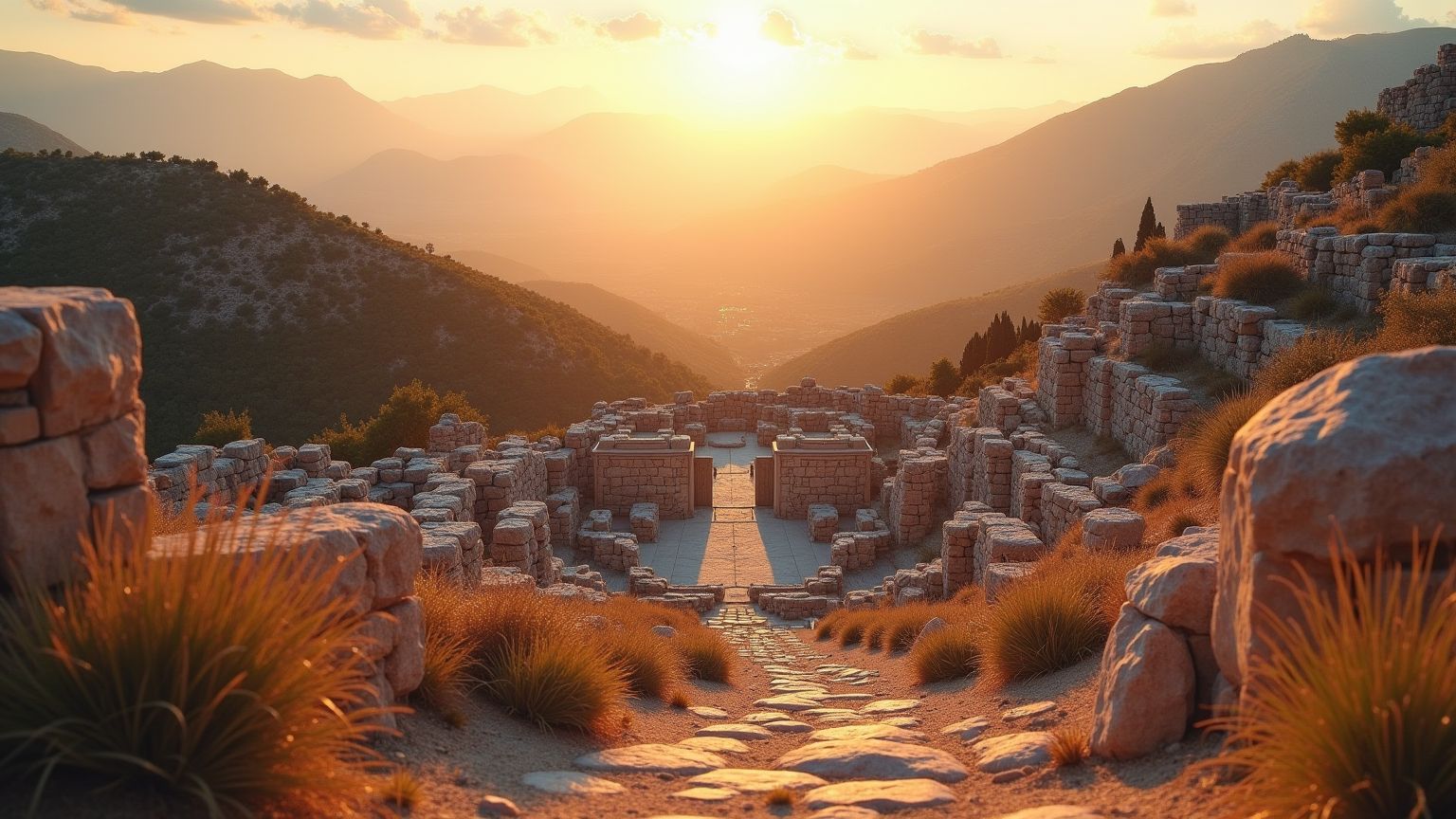Exploring Ancient Mycenae: A Complete Travel Guide from a Local Expert
Hand on heart, I've spent over twenty years guiding wide-eyed travelers through Greece's archaeological treasures, and let me tell you something - nothing quite grabs the soul like Mycenae. This ancient stronghold, surrounded by those impossibly massive stone walls, has been my second home for decades, and I'm itching to spill my hard-earned secrets to you.
The Historical Significance of Mycenae
Mycenae isn't your run-of-the-mill pile of old rocks—it's the beating heart of a civilization that had Greece in its grip from roughly 1600 to 1100 BCE. When you duck through the weathered Lion Gate, you're not just sightseeing; you're literally walking into the pages of Homer's epics. This was Agamemnon's stomping ground, the king who rallied Greek forces to Troy.
What gives Mycenae its goosebump-inducing magic is how it blurs the line between cold hard facts and misty legends. Even the ancient Greeks themselves tipped their hats to this place, believing the mythical Perseus built it with help from one-eyed giants (that's why we call those massive limestone blocks "Cyclopean masonry"). When Heinrich Schliemann—the same treasure-hunting maverick who dug up Troy—struck gold here in the 1870s, he unearthed that jaw-dropping "Mask of Agamemnon," a gleaming death mask that might've covered a ruler's face in their final sleep.
Dig beneath the surface, and Mycenae reveals itself as the nerve center of a seriously sophisticated bunch who mastered engineering, art, and even writing (Linear B—Greek in its diapers). These Mycenaeans weren't homebodies either—they were savvy traders who stretched their connections across the Mediterranean, from Egyptian shores to Sicilian ports. Their cultural fingerprint was so deep that historians named an entire chunk of Greek history after them: the Mycenaean period.
Getting to Mycenae
After countless "Are we there yet?" questions from tourists, I've learned that finding trips up even seasoned travelers. Let me straighten things out:
From Athens
Mycenae sits roughly 120 kilometers (75 miles) southwest of Athens—perfect for escaping the capital for a day. You've got options:
Rental Car: My top pick for most folks. The 1.5-2 hour drive takes you along Athens-Corinth highway, then the national road to Argos, and finally country lanes to Mycenae itself. Signs are plentiful, and having your own wheels means freedom to chase whatever catches your eye in this history-soaked region.
Organized Tour: For those who'd rather someone else handle the headaches. Countless Athens-based operators run Mycenae day trips (usually bundled with Epidaurus and Nafplio) for about €85-110.
Public Transportation: The penny-pincher's path, albeit with some hassles. Hop on a KTEL bus from Athens' Kifissos Terminal to Nafplio or Argos (several daily departures, roughly €15-20), then transfer to a local bus to Mycenae. Fair warning: those local buses run on their own mysterious schedule, so double-check times or you might end up shelling out €25 for a taxi from Argos.
From Nafplio
If you're bunking in postcard-perfect Nafplio (which, trust me, you absolutely should), Mycenae is a mere 24 kilometers (15 miles) away:
- Taxi: Expect to fork over €30-35 one-way.
- Local Bus: KTEL runs services for about €3, but they're as rare as hens' teeth.
- Rental Car: A breezy 30-minute drive through countryside that'll have you pulling over for photos.
When to Visit Mycenae

After experiencing Mycenae in every season (including one memorable hailstorm), I can tell you timing matters more than you'd think:
Best Months: April-May and September-October hit the sweet spot of pleasant weather and thinner crowds. Spring brings an explosion of wildflowers around, creating a photographer's dream against those ancient honey-colored stones.
Summer Considerations: June through August brings tourist swarms and thermometers regularly cracking 35°C (95°F). If summer's your only option, be at the gates when they unlock at 8:00 AM to beat both the masses and the merciless sun.
Winter Visits: November through March offers an underrated experience—mild temps (occasional rain notwithstanding) and blissfully empty pathways. Just double-check those shorter winter hours before making the trek.
Time of Day: Photographers, listen up: early morning and late afternoon create magic as sunlight plays across those ancient stones, casting dramatic shadows that seem to bring the ruins to life.
Essential Sights at Mycenae
When breathless visitors ask what they absolutely cannot miss at Mycenae, these are my non-negotiables:
1. The Lion Gate
This iconic entrance, erected around 1250 BCE, features a mammoth lintel topped by a triangular relief showing two felines (lions or lionesses) flanking a column. Standing as Europe's oldest monumental sculpture, it demands your camera's attention. What most folks walk right over without noticing is the massive threshold stone beneath your feet—take a second to marvel at the engineering prowess needed to maneuver that behemoth into place three millennia ago.
2. Grave Circle A
Just past the entrance lies this circular area containing six royal shaft graves—the very spot where Schliemann hit the archaeological jackpot, uncovering gold masks, intricate jewelry, weapons, and burial treasures (now showcased in Athens' National Archaeological Museum). Fascinatingly, these graves originally stood outside Mycenae's walls but were later enclosed within them—a clear sign of ancestor reverence.
3. The Palace Complex
Climb to Mycenae's highest point to find what's left of the royal digs. While mostly foundations remain today, you can still make out the central megaron (great hall) with its circular hearth. Stand here silently for a moment and picture a Mycenaean king holding court, receiving messengers bearing news that would ripple across the entire Aegean world.
4. The Secret Cistern
My personal favorite feature to show visitors is this underground water system—ancient engineering at its most impressive. A steep, narrow passage with 99 slippery steps descends to this ingenious water storage system that kept Mycenae hydrated during lengthy sieges. Wear proper shoes and bring a flashlight if you're brave enough to venture all the way down into the cool darkness.
5. Treasury of Atreus (Tomb of Agamemnon)
Located a short walk from the main citadel (about 500 meters), this show-stopping tholos tomb features a soaring 13-meter-high dome that remained the world's tallest and widest for over a millennium until the Romans built the Pantheon. The stonework precision will leave you speechless—especially that colossal lintel stone above the doorway, weighing a brain-melting 120 tons!
The Archaeological Museum of Mycenae
One of my pet peeves is watching visitors race through Mycenae without giving the on-site museum a second glance—a massive mistake. While the flashiest Mycenaean bling lives in Athens, this intimate museum provides crucial context that transforms those ruins from pretty piles of stone into a coherent story.
Highlights worth lingering over include:
- Pottery showcasing the evolution of Mycenaean ceramic craftsmanship
- Colorful fresco fragments hinting at the vibrant decorations that once adorned palace walls
- Everyday objects offering glimpses into Mycenaean daily routines
- Clay tablets bearing Linear B writing—tangible evidence of their record-keeping
- Detailed models showing Mycenae in its prime, helping you mentally rebuild those tumbled stones
The museum comes included with your entrance ticket, and I always recommend saving it for after exploring the site when those visual puzzles need solving.
Practical Information for Visitors
Opening Hours and Tickets
- Summer (April 1 to October 31): 8:00 AM to 8:00 PM daily
- Winter (November 1 to March 31): 8:00 AM to 5:00 PM daily
- Closed: January 1, Easter Sunday, May 1, December 25-26
- Admission: €12 for adults, discounts for seniors and students, under-18s get in free
- Smart Money Move: Consider grabbing the combo ticket covering multiple archaeological sites in the Argolis region if you're planning a more thorough exploration
Facilities at the Site
- Small café near the entrance for that post-exploration coffee fix
- Clean restrooms by the ticket office (always a relief!)
- Gift shop stocked with books and souvenirs of varying quality
- Precious little shade, so summer visitors beware
- Water fountain exists, but bringing your own bottle is always wiser
What to Wear and Bring
After watching countless visitors hobble around in flip-flops or designer shoes, I beg you to consider:
- Sturdy shoes with decent grip (those ancient stones are polished slick from millennia of feet)
- Sun hat and serious sunscreen (the Mycenaean hilltop is basically a solar grill)
- Water bottle (at least 1 liter per person during summer)
- Light windbreaker in spring/fall (that exposed hilltop catches every breeze)
- Camera with backup battery (you'll be snapping non-stop)
- Small backpack for essentials (hands-free exploring is always better)
Beyond the Main Site: Hidden Gems
Most tour groups blitz through Mycenae in a rushed hour or two, missing treasures that reward those with curious minds and extra time:
Ancient Mycenaean Bridge
About a kilometer from the main attraction stands an engineering marvel that drops jaws—a bridge built around 1300 BCE that's still standing! Part of the ancient highway network, this corbeled arch elegantly spans a small stream, proving the Mycenaeans weren't just palace-builders but infrastructure geniuses too.
The North Cemetery
For visitors with archaeological interests beyond the superficial, the seldom-visited North Cemetery contains chamber tombs spanning various Mycenaean eras. It's a peaceful area offering insights into how ordinary Mycenaeans (not just royalty) handled their dead.
Modern Mycenae Village
The drowsy little village of Mycenae (Ancient Mykines) near the archaeological wonders houses authentic tavernas where you can refuel after your time-traveling adventures. My personal haunt is Taverna "I Arhontia tou Agamemnona" where Dimitris (ask about his grandfather's excavation stories!) serves Peloponnesian classics using ingredients from his family's land.
Combining Mycenae with Other Nearby Sites
After years crafting tourist itineraries, these combinations work like a charm:
One-Day Itinerary
- Morning: Mycenae (2-3 unhurried hours)
- Lunch: Nafplio's waterfront restaurants
- Afternoon: Epidaurus Theater (2 hours to explore and test the acoustics)
Two-Day Itinerary
Day 1:
- Morning: Mycenae (3-4 hours including that essential museum time)
- Afternoon: Ancient Tiryns (1-2 hours at Mycenae's sister citadel)
- Evening: Wander Nafplio's Venetian lanes and sleep there
Day 2:
- Morning: Epidaurus Theater and Healing Sanctuary (3 hours)
- Afternoon: Either the lesser-known ruins at Ancient Asine or beach lounging at Tolo
Final Tips from a Local Guide
After countless Mycenae visits with everyone from history professors to wide-eyed schoolkids, here's my hard-earned wisdom:
Embrace the Edges of the Day: Mycenae's magic multiplies when crowds thin. That first hour after opening or final hour before closing offers an almost private audience with history.
Look Beyond the Greatest Hits: While the Lion Gate and Treasury of Atreus deservedly draw gasps, take time to absorb the sweeping landscape surrounding Mycenae. Those views across the Argolic Plain to the distant sea explain why these ancient strategists chose this spot.
Marinate in the Mythology: Before visiting, dip into the blood-soaked tales of the House of Atreus and Agamemnon's ill-fated return from Troy. Whether historically accurate or complete fiction, these stories have clung to Mycenae's stones for thousands of years.
Tread Lightly: Despite appearing indestructible, Mycenae is irreplaceable. Stick to marked paths, resist the urge to clamber on ruins for that perfect selfie, and pack out any trash.
Fire Up Your Imagination: As you pass through the Lion Gate, mentally strip away 3,000 years of weathering. Picture vibrant buildings with colorful frescoes, craftsmen hammering bronze, merchants unloading exotic goods from distant ports, and guards pacing those imposing walls.
Mycenae isn't just an impressive collection of ancient rocks; it's a window into a sophisticated Bronze Age world that laid groundwork for everything we recognize as Classical Greek culture. After two decades introducing visitors to this remarkable place, I still discover new details with every visit to Mycenae. Here's hoping your journey to Mycenae leaves you equally captivated and hungry to learn more about these remarkable people who shaped our world.








